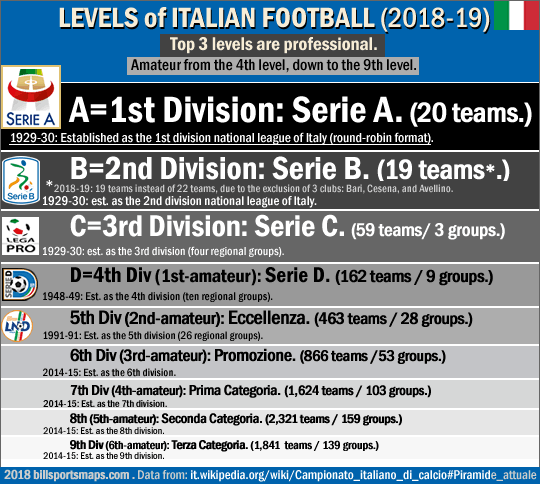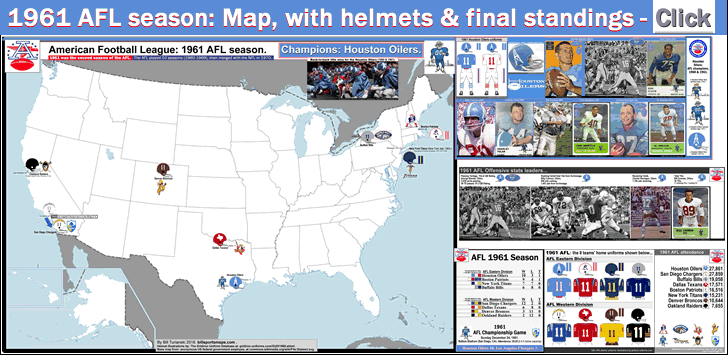
American Football League: 1961 AFL season, map with helmets/jerseys & final standings + offensive stats leaders; champions: Houston Oilers
…
…
By Bill Turianski on 6 December 2018; twitter.com/billsportsmaps.
Links…
-1961 AFL season
-1961 AFL Championship Game (en.wikipedia.org).
-1961 AFL season (pro-football-reference.com).
-1961 AFL teams’ uniforms (illustrations by Gridiron Uniforms Database at gridiron-uniforms.com/[AFL 1961]).
The AFL (of 1960-69) had a 10-year battle with the established pro football league, the NFL.
In 1970, the AFL essentially won the battle, by virtue of the fact that the NFL allowed all 10 of the AFL franchises to join the NFL, in a full dual-league merger. Plus, the AFL won the last two match-ups with the NFL…Super Bowl III (1968 season) saw the AFL’s New York Jets beat the NFL’s Baltimore Colts, and Super Bowl IV (1969 season) saw the AFL’s Kansas City Chiefs beat the NFL’s Minnesota Vikings.
…
The map (click on image at the top of the post)…
The map shows the primary helmets and jerseys worn by the 8 AFL teams of 1961, the second season of the American Football League (IV) (1960-69). At the lower-right of the map-page are the final standings of the 1961 AFL, along with home jerseys and helmets of the 8 AFL teams of 1961. At the bottom-right corner are the attendance figures for the 1961 AFL, with comparisons to 1960 figures. At the upper-right of the map-page are standout players for the champions, the 1961 Houston Oilers. Below that are 1961 AFL offensive leaders in the following categories: Passing Yardage, QB Rating & TD Passes: George Blanda, Houston Oilers. Rushing Yardage and Yards from Scrimmage: Billy Cannon, Houston Oilers. Receiving Yards: Charlie Hennigan, Houston Oilers. Total TDs: Bill Groman, Houston Oilers.
…
The AFL survived its first season of 1960 in debt, but relatively unscathed. Although there was one franchise shift in 1961 (the Los Angeles Chargers moved 120 miles south to San Diego), the 8-team AFL stayed afloat, abetted primarily by the league’s five-year television contract with ABC. In 1961, the AFL as a whole averaged 17.9 K per game, which was a slight increase of 7% from their first season (when the new league drew 16.5 K per game). The true explosion in attendance (and popularity) for the AFL was about 4 years further down the road, though. (By 1965, the AFL would have an overall league-attendance of 31 thousand per game, a figure which was led by huge, plus-40-K-size crowds in New York City and Buffalo, NY.) The AFL as a whole lost about $2 million in its second year. But that was less than half the losses of the first season. There was a definite sense that, after two seasons battling the NFL, the AFL was no longer threatened with survival. In fact, in 1961, three teams – the Boston Patriots, the Buffalo Bills, and the Houston Oilers – did not end up in the red.
Below: chart showing 1960 & 1961 AFL attendances (overall-league-average, and all 8 team-averages ([home regular season games])…
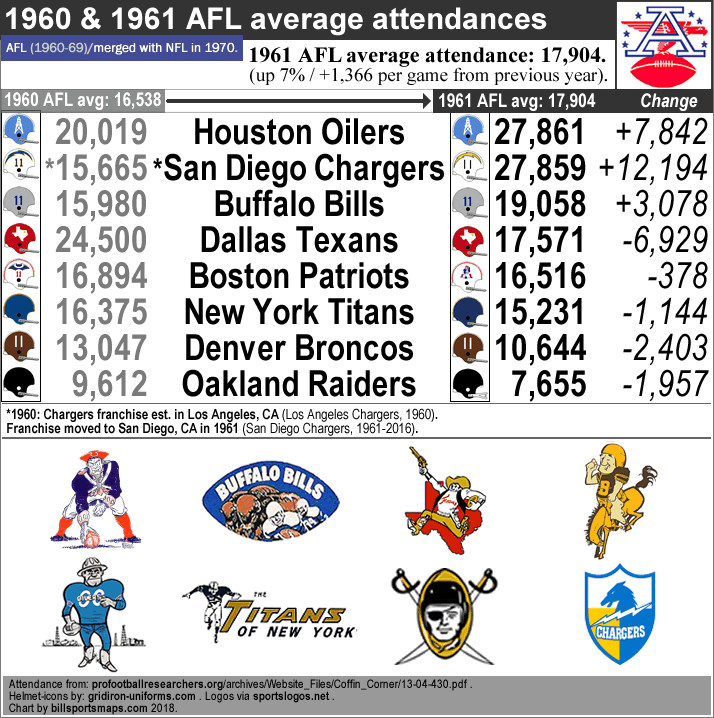
Above: Attendance from: profootballresearchers.org/archives/Website_Files/Coffin_Corner/13-04-430.pdf .
Helmet-icons by: gridiron-uniforms.com. Logos via sportslogos.net. Chart by billsportsmaps.com 2018.
In 1961, the two repeat divisional champions – the Houston Oilers and the San Diego Chargers – were also the best drawing teams.
The Chargers and the Oilers both benefited from the fact that they were from cities which, back then, had no other major-league competition [Major League Baseball would soon place teams in both cities: Houston Astros in 1962, San Diego Padres in 1969]. Both the Oilers and the Chargers drew 27.8 K per game in 1961.
Below are brief profiles of the 8 AFL teams circa 1961…
Houston Oilers.
In 1960, the powder-blue-clad Houston Oilers, drawing a solid 20 K per game, had won the first AFL title (over the Los Angeles Chargers) {1960 AFL map/season, billsportsmaps.com}. And in ’61, in the midst of securing their second-straight title, the Oilers increased their crowds by over 7 thousand per game (at a league-best 27.8 K per game). But after 5 games in the 1961 season, with the Oilers at 1-3-1, owner Bud Adams (AFL co-founder with Lamar Hunt) had fired head coach Lou Rymkus. His replacement was Wally Lemm, who led the Oilers to 9 straight wins to finish the season. And so, on Dec 24 1961, in San Diego, the Oilers faced the Chargers in the AFL title game again. Led by QB/K George Blanda and HB Billy Cannon, and a defense that only gave up 3 points on the day, the Houston Oilers repeated as champions {see illustration further below}.
In 1960, rejected NFL QB George Blanda had came out of retirement to join the Houston Oilers as a 33-year-old. Blanda had been QB/K for the Chicago Bears from 1950-58, but he retired when he learned that George Halas intended to demote him to only placekicking duties. So when the AFL got started up, Blanda realized he could get another shot as a starting QB. In 1960 and ’61, Blanda led the Houston Oilers to the first two AFL titles, setting a TD passing record that stood for 23 years. Blanda threw 36 TD passes in 1961, and was selected as the Associated Press AFL Most Valuable Player. (That 36-TD-passes record was matched by YA Tittle of the NFL’s New York Giants two years later in 1963, and was not beaten until the NFL added 2 games to the season, and was first surpassed by Dan Marino in 1984; and is now held by Tom Brady with 50 TD passes.)
Below: Hall of Fame player who was on the 1961 Houston Oilers: George Blanda (QB/K) [Blanda was 1961 AFL MVP].

Images above – gridiron-uniforms.com/[AFL 1961]; 1962 Fleer card at pinterest.com.
One of Blanda’s main targets as he led the Oilers to those two consecutive AFL titles was Charlie Hennigan. Hennigan was a WR who had played for a small college in Louisiana (Northwestern State), and he had never gotten a chance in the NFL (he wasn’t even drafted by an NFL team). Hennigan was working as a high school football coach and Biology teacher before the AFL came along. In 1961, Hennigan had 12 TD Receptions and had a record-setting 1,746 yards receiving that season. This was a pro football record that stood for 34 years.
Other offensive standouts for Houston in ’61, besides the record-setting Blanda and Hennigan, were…Billy Cannon (HB, with a league-best 948 yards rushing and league-2nd-best 1,534 yards from scrimmage), Charley Tolar (FB, with 796 yards from scrimmage), and Bill Groman (WR, with 1,175 yards receiving and a league-best 18 total TDs). Houston’s offense was so explosive in 1961 that the Oilers ended up scoring 100 points more than any other AFL team that season. The Oilers scored 513 points in 1961 – an average of 36.64 per game. To this day, that is the 4th-best ever in pro football. {See this chart I made from 2013: All-time top 5 pro football offenses…#1: Rams 1950; #2: Broncos 2013; #3: Patriots 2007; #4: Oilers [AFL] 1961; #5: Bears 1941.}
From 1960-64, the Oilers played at the fondly-remembered Jeppesen Stadium, which was basically a glorified high school football stadium (at 36-K-capacity). (The Houston Oilers would go on to play in the Houston Astrodome from 1968 to 1996. The franchise moved to Nashville, TN, as the Tennessee Titans, in the late-1990s.)
…
San Diego Chargers.
After the 1960 season, the LA Chargers had given up on trying to compete for fans with the NFL’s Los Angeles Rams. So the Chargers moved down the freeway to San Diego, into Balboa Stadium [a former racetrack], where a second deck had just been added, making it a 34-K-capacity venue. In 1961, the dark-pastel-blue-clad and gold-lightning-bolt-bedecked San Diego Chargers drew 12 thousand per game more than they had drawn in LA, in 1960. But the Chargers peaked too soon in ’61, and coasted once they’d clinched the division, and then lost to the Oilers, again, in the 1961 AFL title game. And a worrying sign was that the 1961 title game did not sell out (5 thousand tickets went unsold at Balboa Stadium on December 24th, 1961). (The Chargers, under innovative head coach Sid Gillman, would go on to appear in 3 more AFL title games [5 in total], but would only win one AFL title – in 1963, when they demolished the Patriots 51-10. The Chargers would move into the 50-K-capacity San Diego Stadium in 1967, playing there until 2016. The franchise moved back to Los Angeles in 2017.)
Below: Hall of Fame player who was on the 1961 San Diego Chargers: Ron Mix (OT).

Images above – gridiron-uniforms.com/[AFL 1961]; 1961 Fleer card from amazon.com.
…
Buffalo Bills.
Third-best drawing AFL team in 1961 was the up-and-coming Buffalo Bills, who drew 19.0 K at the rock-pile known as War Memorial Stadium. Despite their ramshackle venue, the Buffalo Bills would increase their crowd-size significantly in the following years, up to 43 K per game, en route to their 1964 and ’65 AFL titles. Buffalo might have played in a dump, but the franchise, owned by Detroit-based auto-dealership-heir Ralph Wilson Jr, was one of the three most stable franchises in the early AFL. (The other two stable early-AFL franchises being the Dallas Texans, owned by AFL founder Lamar Hunt, and the Houston Oilers, owned by AFL co-founder Bud Adams, both of whom came from big-oil-money.) In 1961, the Bills were still wearing their original colors of dark-blue-and-silver. The following year (1962), the Bills’ introduced their red-standing-buffalo helmet-logo, and their blue-white-red colors. (The Buffalo Bills would play at War Memorial Stadium until 1972, moving into their purpose-built 80-K-capacity stadium in 1973, in suburban Orchard Park, NY, located 11 miles south-east of Buffalo. The Bills are the only NFL team to lose four consecutive Super Bowl games [1990-93 seasons].)
Below: Hall of Fame player who was on the 1961 Buffalo Bills: Billy Shaw (OG).
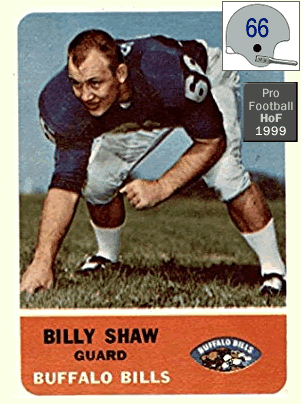
Images above – gridiron-uniforms.com/[AFL 1961]; 1962 Fleer card from amazon.com.
…
Dallas Texans.
Fourth-best drawing AFL team in 1961 was the Dallas Texans, a franchise that would end up in Kansas City, Missouri a couple years later [as the Chiefs]. The red-and-gold clad Texans had been the top draw in the AFL in the first season, drawing 24.5 K per game. This was a particularly impressive figure, when one considers the fact that the Dallas Texans of 1960 had to compete for fans with the also-brand-new NFL expansion team, the Dallas Cowboys. But by 1961, competition with the Cowboys, for the local fan-dollar, was starting to erode the Texans’ support. Attendance fell 7 K per game, to 17.5 K in 1961. Dallas Texans owner-and-league-founder Lamar Hunt was beginning to see that his upstart AFL team could not compete locally with the long-established NFL, especially if (and when) the then-basement-dwelling Cowboys improved. The Dallas Texans would go on to win the 1962 AFL title, only to up stakes and move to Kansas City in 1963. (The Kansas City Chiefs went on to win 2 AFL titles [1966 & 1969], and the Chiefs won the last game ever played by an AFL team, Super Bowl IV [Jan 1970], over the Minnesota Vikings. The Chiefs have not appeared in a Super Bowl game since then.)
Below: standout player who was on the 1961 Dallas Texans: Abner Haynes (HB) [1960 AFL MVP & 1960 AFL Rookie of the Year].
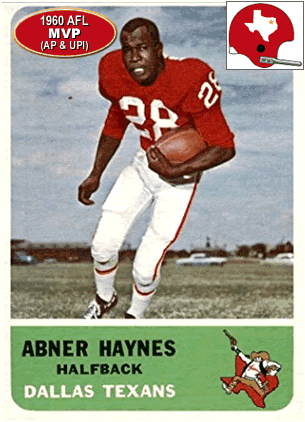
Images above – gridiron-uniforms.com/[AFL 1961]; 1962 Fleer card from amazon.com.
…
Boston Patriots.
Fifth-best drawing AFL team in 1961 was the Boston Patriots, who drew almost exactly the same sized crowds in their first two seasons (16.8 K in ’60; 16.5 K in ’61). The red-white-and-blue clad Patriots played at Boston University’s Nickerson Field. In their first season, the Patriots sported a bizarre-looking helmet-logo: a blue 18th-century-style tri-corner hat, floating on a white field atop red uniform-numbers {see it in the attendance chart further above, or here, at helmethut.com}. They wisely scrapped that confusing logo, and in 1961, the Patriots introduced their new helmet logo, a Minuteman-in-a-3-point-stance-hiking-a-football (aka Pat Patriot; that logo remained up to 1992). As mentioned before, the Patriots broke even in 1961, and this was an example of the relative stability that this franchise offered to the AFL in its wild and woolly early years. But the Patriots in their first eleven years had a vagabond-like existence, playing in 4 different venues…at Boston University (1960-62), then at MLB’s Fenway Park (1963-68), then at Boston College’s Alumni Stadium [in Chestnut Hill, MA] (in 1969), and then at Harvard Stadium (in 1970). In 1971, the Patriots finally got a purpose-built stadium, Foxborough, located completely outside of Boston, 23 miles south-west of downtown Boston, and 21 miles north-east of Providence, RI [hence their name-change to a more regional moniker, the New England Patriots]. (The Patriots would not win a title until 2001, but have now won 5 Super Bowl titles [last in the 2016 season].)
Below: standout player who was on the 1961 Boston Patriots: Gino Cappelletti (SE/K) [1964 AFL MVP].

Images above – gridiron-uniforms.com/[AFL 1961]; 1962 Fleer card from psacard.com/team-sets/1960-1969-decade-patriots.
…
In 1961, there were two struggling AFL franchises: Oakland and New York, plus another bad-drawing team, in Denver.
The Oakland Raiders.
The Oakland Raiders were the last AFL franchise to organize, and this hurt them considerably, because the Raiders had no time to secure a viable venue. The largest football venue on the East Bay was in Berkeley: the University of California’s 81-K-capacity Memorial Stadium. But the Cal administrators refused to let the Raiders play there. So the Raiders were forced to play in San Francisco for their first two seasons. In 1960, the black-helmeted Raiders played at the home of the NFL’s San Francisco 49ers, at Kezar Stadium, and they drew just 9.4 K per game. After their first season the Raiders franchise was half-a million in debt and needed a $400,000 loan from Bills owner Ralph Wilson, Jr. to stay afloat. Then in 1961, the Raiders were forced to play at the windy and cold MLB-venue, Candlestick Park, and the Raiders drew a pathetic 7.6 K per game, and posted the league’s worst record (2-12). All this was because there was no suitable venue yet, across the Bay in Oakland. And the city of Oakland would not finish building the delay-plagued Oakland Coliseum complex for five more years. The Raiders threatened to re-locate, and the city of Oakland responded by slapping together a temporary stadium that was basically scaffolding. That was Frank Youell Field, located in a mixed-industrial area near downtown Oakland. It was supposed to be temporary, but thanks to multiple delays in the building of the Oakland Coliseum, the Raiders ended up playing at the small 22-K-capacity Youell Field for four years (1962-65) {see Raiders in the Youell Field era, in this illustration}. (Al Davis would be hired by the Raiders as head coach/GM, in January 1963, introducing the Raiders’ silver-and-black colors that year.) (The Raiders moved to Los Angeles, CA in 1982. After 13 years in LA, the Raiders moved back to Oakland, CA in 1996. The Raiders will move out of Oakland for the second time in 2019 or 2020, this time to play in Greater Las Vegas, NV. The Raiders won the 1967 AFL title, and have won 3 Super Bowl titles [last in the 1983 season].)
Below: Hall of Fame player who was on the 1961 Oakland Raiders: Jim Otto (C).
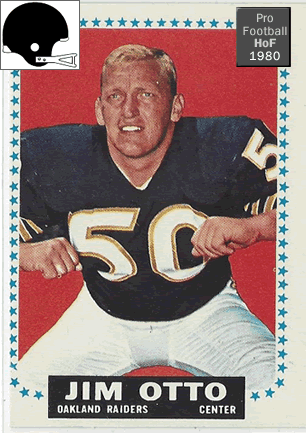
Images above – gridiron-uniforms.com/[AFL 1961] ; 1963 Fleer card from marketplace.beckett.com.
…
New York Titans.
The NY Titans were stuck playing at the decrepit old Polo Grounds on the northern tip of Manhattan, NYC. The Titans were drawing poorly for a big-city team (at 15-K-per-game, which most observers felt was a grossly inflated figure). And the Titans ownership group was so cash-strapped that the following year, in order to meet payroll, the franchise would need big cash infusions from Dallas Texans owner-and-league-founder Lamar Hunt. (In 1963, the dark-blue-and-gold clad New York Titans franchise changed ownership, and became the green-and-white clad New York Jets. Then in 1964, the NY Jets would move out of the soon-to-be-demolished Polo Grounds, and into the big new municipal venue built by the City of New York, Shea Stadium in Queens, NYC. And in the ensuing years (1964-on), the Jets’ league-leading attendance would go on to skyrocket past 50 K per game, then past 60-K per game [and to full-capacity at Shea] by ’67. The New York Jets went on to win the 1968 AFL title, then the plucky Jets upset the NFL’s Baltimore Colts to win Super Bowl III [Jan. 1969]. The Jets have not appeared in any title game since then. The NY Jets have played in the state of New Jersey since 1984 [sharing a venue with the NY Giants].)
Below: Hall of Fame player who was on the 1961 New York Titans: Don Maynard (E).
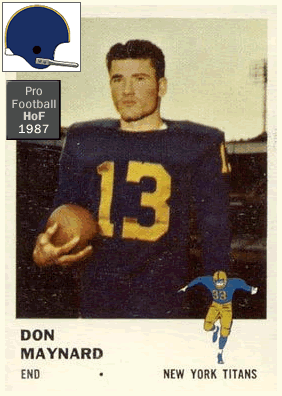
Images above – gridiron-uniforms.com/[AFL 1961]. 1962 Fleer card, unattributed at pinterest.com.
…
Denver Broncos.
In 1961, the brown-and-mustard-yellow clad Denver Broncos were also drawing poorly, pulling in just 10.6 K per game. But time would later show that the Broncos’ sparse crowds in their first few seasons was mainly a result of how bad the team was (the Broncos went 3-11 in 1961). First proof of that was a year away: in 1962, the now-orange-and-blue clad Broncos won 4 more games, going 7-7, and drawing over 14 thousand more per game, at 25.4 K. (The Denver Broncos have remained on the same site in Denver since their inception in 1960…playing at Bears Stadium/Mile High Stadium [for 41 years up to 2000], and then at Broncos Stadium at Mile High [since 2001]. The Denver Broncos have won 3 Super Bowl titles [last in the 2015 season].)
Below: standout player who was on the 1961 Denver Broncos: Lionel Taylor (SE) [5-time All-AFL].
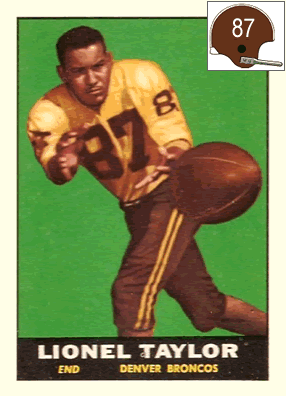
Images above – gridiron-uniforms.com/[AFL 1961]; 1961 Topps card from vintagecardprices.com.
…
1961 AFL Championship game (the Houston Oilers beat the Chargers in the title game, for the second straight season)…
The 1961 AFL title game was marred by poor officiating. It also featured 13 turnovers. Oilers QB George Blanda gave up 5 interceptions. But his 35 yd TD pass to Billy Cannon in the 3rd Q was the difference (see photos below). The irony was that the Houston Oilers, who had a high-powered offense that set records in 1961, won the AFL title that year thanks to a defense that kept the Chargers from scoring a TD.

Photo and Image credits above – 1961 AFL title game at Balboa Stadium, program from afl-football.50webs.com. George Blanda scrambling, photo by Hy Peskin at hypeskin.com/1961-afl-championship-houston-oilers-at-san-diego-chargers. George Blanda [photo from 1961 AFL Title game], photo by Hy Peskin at gettyimages.com. Billy Cannon on sideline, photo by Hy Peskin at hypeskin.com. Billy Cannon making a reception, photo by David F. Smith/Associated Press via nytimes.com/2017/11/02/sports/houston-championships. Chargers coaches berate lineman, photo unattributed at goldenrankings.com/AFLchampionship1961. Los Angeles Examiner headline Dec 25 1961, “Old Pro Blanda Whips Gillman Again”, from ebay.com. George Blanda scrambling, photo unattributed at fs64sports.blogspot.com. Oilers [1960 photo] in huddle, unattributed at sportsecyclopedia.com/nfl. Charlie Hennigan, unattributed at nflpastplayers.com. Oilers players on bench [photo circa 1961], screenshot from Full Color Football #1 uploaded by TheAFLHistory at youtube.com.
__
Photo and Image credits on the map page…
Houston Oilers,
Oilers players on bench [photo circa 1961], screenshot from Full Color Football #1 uploaded by TheAFLHistory at youtube.com. Reproduction of 1960-61 Houston Oilers helmet, photo from supersportscenter.com. George Blanda [photo circa 1964], unattributed at goldenrankings.com. George Blanda [photo from 1961 AFL Title game], photo by Hy Peskin at gettyimages.com. Don Floyd [1961 Fleer card], from marketplace.beckett.com. Billy Cannon [photo circa 1961], unattributed at fanbase.com. Charley Tolar [1965 photo/re-done as quasi=1961 Fleer card], from boblemke.blogspot.com. Bill Groman [photo from 1960], photo unattributed at sportsecyclopedia.com/[Houston Oilers]. Tony Banfield [1962 Fleer card], from footballcardgallery.com. Charlie Hennigan [photo circa 1964], unattributed at crazycantoncuts.blogspot.com. Al Jemison [1962 Fleer card], from ebay.com.
…
Offensive stats leaders on map page,
George Blanda [photo circa 1961], photo unattributed at fs64sports.blogspot.com. Billy Cannon [photo circa 1962], from AP via chron.com/sports. Charlie Hennigan [photo from 1961 AFL title game], photo by http://hypeskin.com/wpbeta/1961-afl-championship-houston-oilers-at-san-diego-chargers//wpbeta/1961-afl-championship-houston-oilers-at-san-diego-chargers/”>hypeskin.com. Bill Groman [1961 Fleer card], from amazon.com.
…
Thanks to,
-Blank map by anonymous US federal government employee, at File:StatesU.svg (commons.wikimedia.org).
-Thanks to Sportslogos.net for 1960-era AFL team logos.
-Thanks to Buffalo Bills official site for original Bills logo (1960-61).
-Thanks to Infinite Jets blog for hard-to-find full-color NY Titans logo.
-Thanks to the Coffin Corner newsletter, for this pdf, profootballresearchers.org/archives/Website_Files/Coffin_Corner/13-04-430.pdf [AFL attendance by team 1960-69] .
-Thanks to the contributors at pro-football-reference.com.
-Thanks to the contributors at AFL 1961 season (en.wikipedia.org).
-Special thanks to Tim Brulia, Bill Schaefer and Rob Holecko of The Gridiron Uniform Database, for giving billsportsmaps.com the permission to use football uniforms illustrations from Gridiron Uniform Database {GUD}.

